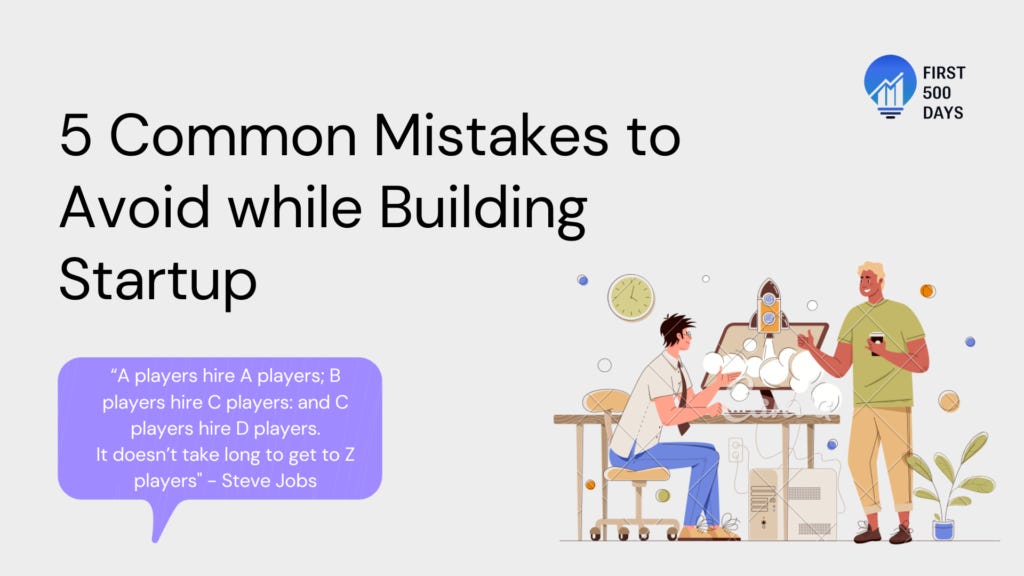Understand with an Example of Anirudh’s Strategy | If you have to learn startup, don’t afraid to fail! Just start!
In today’s edition, we will discuss 5 common mistakes “First-Time Founders” make while building strategy through an example of Anirudh.
Disclaimer: Everything is fictitious for explaining things.
Let’s say Anirudh, with his 2 Co-founders (all first-time founders), came up with the idea of building a Marketplace Platform for Selling Art where artists can list their products and art lovers can purchase them.
Now, Anirudh has designed a strategy based on conventional knowledge that most first-time founders follow.
Strategy is
- First, release the platform in the market, then approach customers
- Build a product with maximum features for serving all customers
- Acquire customers through paid marketing and discounts
- In a later stage, discuss shareholding among founders
- Rest plan later after achieving the above goals
Let’s learn from the store of Anirudh’s strategies and keep us on the safe side.
1. First, release the platform in the market, then approach customers.
This is his first mistake.
Anirudh thought that once he had the platform, he didn’t have difficulty engaging customers, so he directly jumped into product building.
It doesn’t matter how advanced his product is; if he cannot reach the target customer, his product will go in vain.
In his product, there will be 2 stakeholders
- Artist
- Art Lovers
Here bringing artists on the platform is not a big deal but getting Art Lovers is the challenge.
So he should first start with building funnels for getting Art lovers.
It will benefit him in 2 ways
- He can get instant feedback from real customers.
- He will have an initial audience who love to signup on his platform.
2. Build a product with maximum features for serving all customers
This is another mistake.
See, customers won’t increase suddenly on the platform. Customer acquisition takes time.
The concept of features is to serve maximum use cases of customers.
For example, there are, let’s say, 200 Mn art lovers across the world. They can be further classified into interest, behavior, demographic, and psychology.
For the first 100 customers, he should pick a specific category that needs limited features.
He needs more features for the next 1000 customers based on their interests.
For the next 10,000 customers, he needs more features to handle them.
From 1st day, he shouldn’t build products for millions of users but first, build for 100, then 1000, then 10,000, and so on…
It will save his time and efforts and eventually will increase his success rate.
3. Acquire customers through marketing and discounts from own money
This is another mistake of Anirudh.
To acquire customers, he doesn’t always need to give discounts. He should start with those customers for whom his solution is a pain killer.
Those customers won’t need a discount. They require trust and transparency.
He doesn’t need to spend a lot of money initially to convince those customers for whom his solution is like vitamin pills.
4. Discussing shareholding among founders in a very late-stage
This is another mistake.
Most startups shut down because of team issues. In a team, all members won’t put their efforts equally. Some put more effort, some less.
The person putting maximum effort asks for more equity compared to other founders.
So it’s always better to discuss shareholding among founders asap so that clashes later can be avoided.
Most founders discuss shareholding at the fundraising time or try to avoid it as much as possible because this is a sensitive topic.
5. Not having a long-term execution plan
It’s obvious that when we startup, we don’t know how things will go, but it’s always good to have a long-term plan so that you should be aware of the direction where you are moving.
If you don’t have a long-term plan, you may put in a lot of effort with zero results.
So having a long-term plan is a must.
Thanks for the read
What Next?
If you liked this content, follow us on LinkedIn, Twitter, Instagram, and Youtube and share it with your friends.
You are welcome to join the Founders’ Community. The only community where you can network and learn from peer founders.
If you are building your startup, don’t forget to check out our upcoming Startup Cohort.
If you have any suggestions, I would be happy to listen here.


